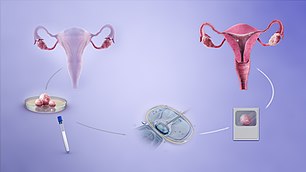Hydrosalpinx
| Hydrosalpinx | |
|---|---|
Gynecology |
A hydrosalpinx is a condition that occurs when a
Hydrosalpinx is a composite of the Greek words ὕδωρ (hydōr – "water"[2]) and σάλπιγξ (sálpinx – "trumpet"[2]); its plural is hydrosalpinges.
Signs and symptoms


Symptoms can vary. Some patients have lower often recurring abdominal pain or pelvic pain, while others may be asymptomatic. As tubal function is impeded, infertility is a common symptom. Patients who are not trying to get pregnant and have no pain, may go undetected.
Endometriosis, ruptured appendicitis, and abdominal surgery sometimes are associated with the problem. As a reaction to injury, the body rushes inflammatory cells into the area, and inflammation and later healing result in loss of the fimbria and closure of the tube. These infections usually affect both fallopian tubes, and although a hydrosalpinx can be one-sided, the other tube on the opposite side is often abnormal. By the time it is detected, the tubal fluid usually is sterile, and does not contain an active infection. (Not symptoms)
Cause
The major cause for distal tubal occlusion is
While the
Other causes of distal tubal occlusion include adhesion formation from surgery, endometriosis, and cancer of the tube, ovary or other surrounding organs.
A hematosalpinx is most commonly associated with an ectopic pregnancy. A pyosalpinx is typically seen in a more acute stage of pelvic inflammatory disease and may be part of a tubo-ovarian abscess.
Tubal phimosis refers to a situation where the tubal end is partially occluded, in this case fertility is impeded, and the risk of an ectopic pregnancy is increased.
Diagnosis
Hydrosalpinx may be diagnosed using
When laparoscopy is performed, the surgeon may note the distended tubes, identify the occlusion, and may also find associated adhesions affecting the pelvic organs. Laparoscopy not only allows for the diagnosis of hydrosalpinx, but also presents a platform for intervention (see management).
Prevention
As pelvic inflammatory disease is the major cause of hydrosalpinx formation, steps to reduce sexually transmitted infection will reduce incidence of hydrosalpinx. Also, as hydrosalpinx is a sequel to a pelvic infection, adequate and early antibiotic treatment of a pelvic infection is called for.
Management
For most of the past century patients with tubal infertility due to hydrosalpinx underwent tubal corrective surgery to open up the distally occluded end of the tubes (salpingostomy) and remove adhesions (adhesiolysis). Pregnancy rates tended to be low as the infection process often had permanently damaged the tubes, and in many cases hydrosalpinges and adhesions formed again. Further, ectopic pregnancy is a typical complication.[3] Surgical interventions can be done by laparotomy or laparoscopy.
Non-infertile patients who suffer from severe chronic pain due to hydrosalpinx formation that is not relieved by pain management may consider surgical removal of the affected tubes (salpingectomy) or even a hysterectomy with removal of the tubes, possibly ovaries.
IVF
Among the main causes for female infertility, tubal factors account for 25-35%.[4] In particular, hydrosalpinx is found in 10-30% of couples with infertility; actually, this condition may impair fertility and IVF outcomes.[5]
With the advent of
Several studies have shown that IVF patients with untreated hydrosalpinx have lower conception rates than controls and it has been speculated that the tubal fluid that enters the endometrial cavity alters the local environment or affects the embryo in a detrimental way.[6] Indeed, the presence of hydrosalpinx prior to IVF treatments, negatively affects pregnancy rates and increases the risk for spontaneous miscarriage.[7] Even if the exact mechanism remains unclear, these effects could be ascribed to a combination of mechanical effects of hydrosalpinx fluid, toxic effects on the embryo and altered endometrial receptivity[8] Thus, many specialists advocate that prior to an IVF attempt, the hydrosalpinx should be removed.[6] However, the benefits seem to be higher when the hydrosalpinx is bilateral, visible on ultrasound, or both.[6] Salpingectomy removes the chronically infected hydrosalpinx, decreasing the risk of infection after oocyte retrieval and increasing the accessibility to the ovary; anyway, it is a surgical procedure and it could also affect the ovarian blood flow.[9]
History
References
- ^ "Hydrosalpinx". www.reproductivefacts.org. Retrieved 2022-06-30.
- ^ a b Liddell, H.G. & Scott, R. (1940). A Greek-English Lexicon. revised and augmented throughout by Sir Henry Stuart Jones. with the assistance of. Roderick McKenzie. Oxford: Clarendon Press.
- PMID 11239547.
- ^ Honoré GM, Holden AE, Schenken RS. Pathophysiology and management of proximal tubal blockage. Fertil Steril. 1999 May;71(5):785-95. doi: 10.1016/s0015-0282(99)00014-x. PMID 10231034.
- PMID 16962113.
- ^ PMID 10548619.
- ^ Blazar AS, Hogan JW, Seifer DB, Frishman GN, Wheeler CA, Haning RV. The impact of hydrosalpinx on successful pregnancy in tubal factor infertility treated by in vitro fertilization. Fertil Steril. 1997 Mar;67(3):517-20. doi: 10.1016/s0015-0282(97)80079-9. PMID 9091340.
- ^ Ozmen B, Diedrich K, Al-Hasani S. Hydrosalpinx and IVF: assessment of treatments implemented prior to IVF. Reprod Biomed Online. 2007 Feb;14(2):235-41. doi: 10.1016/s1472-6483(10)60792-4. PMID 17298728.
- ^ Grynnerup AG, Lindhard A, Sørensen S. Anti-Müllerian hormone levels in salpingectomized compared with nonsalpingectomized women with tubal factor infertility and women with unexplained infertility. Acta Obstet Gynecol Scand. 2013 Nov;92(11):1297-303. doi: 10.1111/aogs.12234. Epub 2013 Oct 4. PMID 24032634.
- PMID 9080233.
- ^ Alexander Skene (1890). Treatise on the Diseases of Women. D. Appleton & Co, New York, 1889.
